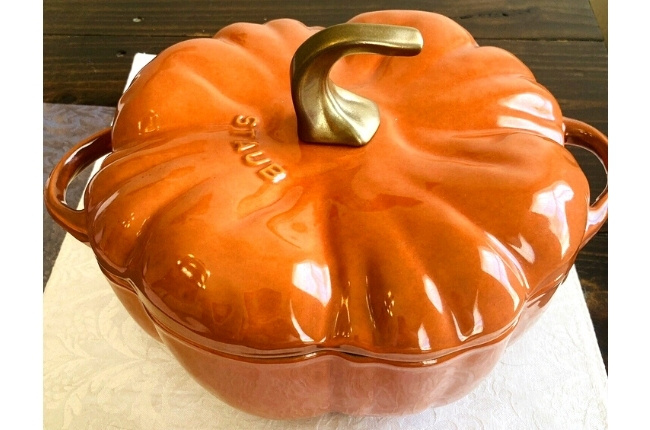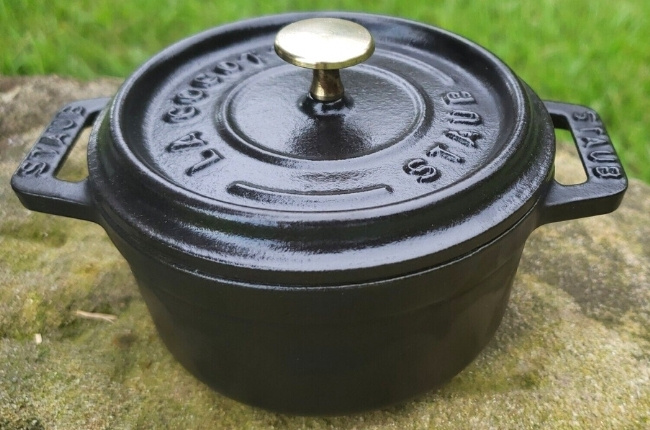There’s nothing more horrifying than buying expensive cookware and finding out it doesn’t work on your cooktop!
That’s probably why you are here. You want to find out if Staub, the brand you have been saving up and eyeing for a while now, can work with another modern addition to your home— the sleek induction cooktop.
Since Staub is one of the most popular and trusted brands of cookware out there, it’s hard to find any reason not to opt for it. But does Staub work on induction?
Spoiler alert: YES.
Is STAUB good for induction?

When one talks about cookware, the number of existing brands in the market can be overwhelming. And honestly, not all of them are worth their price point.
So, what can you do?
Well, if you are a kitchen newbie or a cookware hunter, the best option is to trust the giants in the field. These big names have the history to back up their claims, the innovation, and the heirloom quality that we all seek in kitchenware.
One of these giants is Staub, the French manufacturer most famous for its cast iron cocotte (French ovens).
Before you delve into the induction compatibility of Staub cookware, you must first explore what makes Staub a statement piece you definitely would want in your home.
Cast Iron Cookware

Cast iron is a sought-after material due to its high thermal retention and natural durability. Staub’s cocottes, popularly known as French or Dutch ovens, take enamelware to a golden standard.
No Staub cookware is the same.
Staub individually molds their cast iron cookware. After rigorous testing, burring, and smoothing down, the piece gets coated with three layers of enamel. Three!
The enamel layers provide a glossy, vibrant finish that makes the cookware extra durable, scratch and chip resistant, and saves you from pre-seasoning your cookware.
RELATED READ: Can cast iron be used on induction cooktops?
Moreover, the enamel provides a non-stick and non-reactive coating. They are free of PTFE, PFOA, lead, and cadmium.
If you are the type to sear and cook food at a higher temperature, Staub cast iron’s dark interior won’t leave you frowning at the food stains and sticking meat. The semi-rough texture also allows better browning of the meat.
And if you look at the inner side of your Staub cocotte’s lid, you will see these unique “spikes”. This interesting design, plus the tight lid, ensures impressive moisture retention.
The spikes provide condensation points where moisture and evaporated juices can fall back into the meat. You won’t even need to baste to get that tender flavor from your meat!
Although their cocotte is their most famed piece, Staub’s cast iron cookware offers several products with the same impressive quality.
Ceramic Cookware
Staub’s cast iron cookware is mostly unrivaled. However, it doesn’t mean that their ceramic products did not undergo the same attention to detail.
The ceramic pieces are at a lower cost. They also come in beautiful colors, so it’s great if you like your kitchen aesthetically pleasing. Albeit the glossy appearance, they are remarkably scratch and fingerprint-resistant.
If you are looking for your next bakeware, their ceramic products will not disappoint you. The surface is non-porous and does not retain food odor.
Staub’s ceramics can go from freezer to oven immediately and will not crack in the process!
With their ergonomic design, you can stack them with ease. You get to save space, ensure food safety, and keep your kitchen pretty!
Now that you know more about Staub let’s look at how they adapt to the modernity in the kitchen.
The big question, of course, focuses on induction cooktops.
A material like Staub’s popular cast iron cookware is ferromagnetic and produces heat in the presence of a changing magnetic field.
But how does it all relate to your Staub cookware and induction cooktop?

The Science of Induction
“Induction” is a shortened term for electromagnetic induction.
While it may sound like something you have heard from a science fair and forgotten over time, understanding what’s going on in your cooktop lets you make smart choices on your cookware.
Every induction cooktop has a coil of metal, typically copper, underneath the glass surface. When you power up the cooktop, an alternating current flows through this coil, resulting in a fluctuating magnetic field.
With changing magnetism, you produce an eddy current that goes through the compatible cookware. The current swirls around the metal structure, and this disturbance causes the metal to release energy in the form of heat.
In other words, changing electric current produces a changing magnetic field which ultimately heats the suitable material.
It does not work for EVERY material.
If you put stoneware on an induction cooktop, it sure won’t heat up. Stoneware isn’t ferromagnetic and, therefore, not induction-ready.
The materials deemed induction-compatible are cast iron, enamel on metal, and stainless steel. However, bare copper, aluminum, glass, and ceramics are unsuitable.
So, can you use Staub on induction?
Yes! You can use your Staub cast iron on your next induction adventure! As for Staub’s ceramics, they are better for your baking experiments in the oven.
Do STAUB Dutch ovens work on induction?

If you are browsing for Staub cookware, you probably encountered cocotte.
They look like your regular dutch ovens, and hopefully, they function the same. Are they the same, and if so, will a French cocotte work on induction too?
No one knows who coined the term “dutch oven”. Somehow, in the history of the Dutch casting process, a round vessel or pot came with a tight lid, and there came about the dutch ovens.
Moreover, as European cuisine evolved, shapes and sizes of the “original” dutch oven varied too— and so did their name.
The original model of the dutch oven utilizes raw cast iron. When cocottes came about, they brought with them vibrant enameled surfaces. To some, this enamel coating differentiates dutch ovens from French cocottes.
However, they are interchangeable nowadays since dutch ovens are also available in enameled cast iron. And they function the same as dutch ovens, albeit with slight differences in weight, design, and suitability for specific dishes.
Dutch ovens generally branch out to other materials like stainless steel and five-ply aluminum that are also induction-ready, whereas Staub cocottes utilize enameled cast iron only.
You can definitely use your Staub cocotte or dutch oven on induction!
Do Staub pans work on induction?
Like its cast iron cocotte cousins, Staub pans are perfectly compatible with all heat sources, including induction. They have a wide selection of pans that you must check out on your next shopping spree.
Staub’s cast iron skillet is probably the most regarded among the pans available from Staub. It has fantastic browning capabilities and does not require prior seasoning.
This skillet also has two pour spouts which make transferring liquids easier. The overall ergonomic design makes for a durable and easy-to-use enameled cast iron.
The pans also come in stackable sets, so if you plan to splurge, this is your green light. And while you are at it, browse their wok, grill pans, and braisers.
PS. If you plan to have a paella or jambalaya lunch, Staub’s sauté pans are perfect for getting that authentic flavor to your dinner table.
Can Staub cast iron be used on induction?
If there is a material exactly suited for induction cooktops, it would be cast iron. So yay!
You are on the right path if you just purchased a new Staub cast iron cookware to complement your sleek induction cooktop!
You’ll probably hesitate to place traditional cast iron on your glass induction. The rough surface is a sure recipe for scratches. But with Staub, the three layers of enamel provide a smoother coating. It is also generally lighter than traditional cast iron.
What’s more to love? Staub’s cast iron cookware and accessories do not stop with their cocottes. They have different pans, au gratins, tea kettles, and fondue pots!
They even have specialty items like the pumpkin cocotte and accessories like silicone handles and trivets to improve your cooking experience.
The dutch ovens also come in mini form. Since they are on the heavier side compared to other popular dutch ovens of the same size, getting a small to medium dutch oven would also ensure that you lessen the impact on the induction surface.
PS. Always be gentle when placing something on the induction, and wipe down any leftovers to avoid scratching the induction surface.
To check whether your cookware is induction-ready, like Staub’s cast iron set, place a magnet at the bottom of your cookware. If it sticks well, then you can go on your merry way!

Leave a Reply